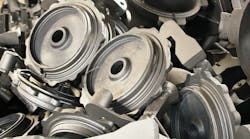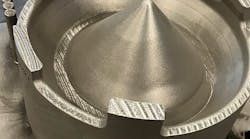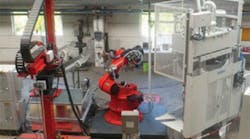It’s a good time to be supplying robots for metalcasting. Developers and suppliers of automation technologies agree that there is exceptionally strong demand from foundries and diecasters for new and updated robots. “A lot of it has to do with the resurgence of the auto industry,” explained Rimrock Corp. vice president and general manager Jerry Osborn, “in particular for structural components made from aluminum.”
There is a convergence of factors in this development. “Cycle time is one consideration, so higher throughput is a goal,” Osborn continued. “Their volumes are increasing, and so some of the metalcasters are trying to increase the throughput in their existing operations.”
And that’s not all. “Quality is another reason, especially for finishing,” according to the Rimrock exec. “The consistency and quality of finishing with a robot is typically much better than it is for a manual operation: deburring, degating, grinding, sawing, things like that.
“And then for pouring,” he said, “you know that process is very labor-intensive and slow, and it can be done more quickly and accurately with a robot than manually. So, if for example you’re taking 100 lb of hot metal and pouring it into a mold, the robot can do that very quickly and efficiently versus one man or two men.”
Nor is the current steady demand for robots involve just the high-volume automotive foundries. “We also have small metalcasters, even 10- to 15-man operations, that are starting to get interested in robotics,” according to Osborn, whose firm develops and integrates installations with ABB Robotics equipment.
The reasons for metalcasters to adopt robots are not new, but the technologies available to them are presenting a range of capabilities that make the investment more than a laborsaving strategy.
At GIFA 2011, Reis GmbH introduced a diecasting work cell that centers on a robot capable of interfacing with all the active equipment — the diecasting machine, the die-spray equipment, removal devices — and with the ability to control all critical parameters, from the quench tank to the trim press. It has emergency shut-off capability too, and the entire production process is displayed by a graphical user interface that indicates the progress of production and the location of any mishaps.
“The customers of Reis expect innovative solutions supporting an efficient production,” according to sales manager Rudolf Brand. “In case of failures in the casting process, operators in the past had to search for all potential error sources and points, whereas Reis now allows direct identification of the cause on a central monitor. Since every production failure costs money, this economical solution amortizes within a very short time.”
Reis has been designing robots for more than 50 years, with an emphasis on integrated production systems for casting, as well as welding, laser processing, assembly, and other industrial processes.
Diecasting may allow a greater degree of standardization, with a more focused area of production activity than molding foundries present. Rimrock’s Osborn observed that robots installed in foundries draw from a portfolio of equipment and capabilities that are customized to fit the operating location and the production stream.
“We have standardized concepts or building blocks,” he said. “We know how to do a pouring robot, a sawing robot, a finishing robot, so we can standardize some elements that we can use to build a customized system, but typically every job is unique: it’s a custom design that depends on the plant layout and the parts, and the function.”
The progress of robotic technology and the emergence of new functions make these installations even more consequential for the metalcasters that adopt them. For example, finishing robots are among the most widely deployed, but the dimensional variations of castings are infinite. ABB Robotics this year introduced standardized packages of motor and gear units so that robotics integrators can customize axis systems. The motor and gear units are available in all-inclusive packages with cabling, serial measurement board (SMB) box, optimization software, and safety options. Customizing the axes means that the integrator has even more flexibility for optimizing robotic finishing to specific casting desgns. The packages optimize performance and cost-efficiency, and simplify the design, integration and operation of additional robot axes, like workpiece positioners, track motions, indexing conveyors, and other factors.
“The packages are completely preengineered, providing the means for our integrators to easily spec and build external axis systems with ABB motors, gears and cables, and to simplify their integration with our robots and controllers,” said Joe Campbell, v.p. of the ABB Robot Products Group in the U.S. The motor units are supplie in four sizes, including an extra-large motor (MU400) for high-power applications like turntables; and the gear units are offered in the seven versions that are built into ABB’s positioners, including both MTD (for positioning) and MID (for interchange) units.
While the Reis work cell is premised on the availability of a standardized interface between a robot, the production machinery, and the peripheral equipment, Rimrock’s Jerry Osborn believes that the critical factor enhancing the impact of robotic technologies is programming — offline programming.
An ABB software package called RobotStudio allows programmers to visualize an installation and evaluate a robot’s performance in exceptional detail, speeding up development time. It references CAD data on workpieces and design capabilities for robots and their components, in order to prove an installation’s effectiveness.
“We can show a customer what their part will look like, what their cell will look like, and how the robot is going to move. We can prove out cycle times,” Osborn said, emphasizing that all this is possible before the robot has been chosen or installed. “Afterward, we can do all that as we are building the system, and the programming time is very much minimized.”
As for robotic functionality, the integrator reported that path-following is now exceptionally well advanced, “and that’s important in finishing, being able to accurately follow the curvature of a part.
“There is a force sensing technology that can allow you to adapt the robot performance according to a part that is changing,” Osborn said. “So, for example, if you’re deburring a part and you run into a bigger chunk of metal, the robot will slow down rather than (as in the past) go through it at a constant speed, and possibly tear up the tool or the part. You can also apply a constant force if you’re trying to do a sanding or polishing operation. Just apply a constant force with the robot, and even if the part is moving up or down, the robot adjusts to apply a constant pressure to that part.”
And as for the future, Osborn advised metalcasters to watch for improvements in robots’ information processing capability, allowing them to monitor process parameters. For example, he listed metal temperatures and volumes, or mold or die temperatures, all of which may require an adjustment in a metalcasting production process. “Being able to tie those process parameters into what the robot is doing,” he offered, “those are some of the things we’re working on now.”












